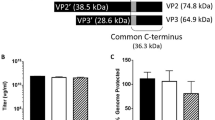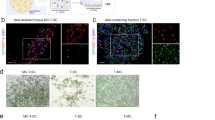Abstract
Transduction of 11 pancreatic cancer cell lines with a replication-deficient adenovirus 5 expressing enhanced green fluorescent protein (Ad5EGFP) was analyzed and variable EGFP levels were observed, ranging from <1% to ∼40% of cells transduced, depending on the cell line. Efficient Ad5EGFP transduction was associated mainly with higher levels of cell surface Coxsackie and adenovirus receptor (CAR) but not with expression of αvβ3 and αvβ5 integrins and was fiber dependent. Reduction of CAR by RNA interference resulted in a corresponding decrease in Ad5EGFP transduction. Pre-treatment of Ad5EGFP with blood coagulation Factor X increased virus entry even in the presence of low CAR levels generated by RNA interference, suggesting a potential alternative route of Ad5 entry into pancreatic cancer cells. Immunohistochemistry carried out on 188 pancreatic ductal adenocarcinomas and 68 matched controls showed that CAR was absent in 102 (54%) of adenocarcinomas, whereas moderate and strong staining was observed in 58 (31%) and 28 (15%) cases, respectively. Weak or absent CAR immunolabeling correlated with poor histological differentiation of pancreatic cancer. In normal tissue, strong immunolabeling was detected in islet cells and in the majority of inter- and intralobular pancreatic ducts.
This is a preview of subscription content, access via your institution
Access options
Subscribe to this journal
Receive 12 print issues and online access
$259.00 per year
only $21.58 per issue
Buy this article
- Purchase on Springer Link
- Instant access to full article PDF
Prices may be subject to local taxes which are calculated during checkout





Similar content being viewed by others
Abbreviations
- Ad:
-
human adenovirus
- CAR:
-
Coxsackie and adenovirus receptor
- EGFP:
-
enhanced green fluorescent protein
- FX:
-
Factor X
- vp:
-
virus particles
References
Parkin DM, Bray F, Ferlay J, Pisani P . Global cancer statistics, 2002. CA Cancer J Clin 2005; 55: 74–108.
Carpelan-Holmström M, Nordling S, Pukkala E, Sankila R, Lüttges J, Klöppel G et al. Does anyone survive pancreatic ductal adenocarcinoma? A nationwide study re-evaluating the data of the Finnish Cancer Registry. Gut 2005; 54: 385–387.
Wong HH, Lemoine NR, Wang Y . Oncolytic viruses for cancer therapy: overcoming the obstacles. Viruses 2010; 2: 78–106.
Zhang Y, Bergelson JD . Adenovirus receptors. J Virol 2005; 9: 12125–12131.
Hall K, Blair Zajdel ME, Blair GE . Unity and diversity in the human adenoviruses: exploiting alternative entry pathways for gene therapy. Biochem J 2010; 431: 321–336.
Arnberg N . Adenovirus receptors: implications for tropism, treatment and targeting. Rev Med Virol 2009; 19: 165–178.
Waddington SN, McVey JH, Bhella D, Parker A, Barker K, Atoda H et al. Adenovirus serotype 5 mediates liver gene transfer. Cell 2008; 132: 397–408.
Kaluzhniy O, Di Paolo NC, Silvestry M, Hofherr SE, Barry MA, Stewart PL et al. Adenovirus serotype 5 hexon is critical for virus infection of virus infection of hepatocytes in vivo. Proc Natl Acad Sci USA 2008; 105: 5483–5488.
Jonsson MI, Lenman AE, Frängsmyr L, Nyberg C, Abdullahi M, Arnberg N . Coagulation Factors IX and X enhance binding and infection of Adenoviruses types 5 and 31 in human epithelial cells. J Virol 2009; 83: 3816–3825.
Moore PS, Sipos B, Orlandini S, Sorio C, Real FX, Lemoine NR et al. Genetic profile of 22 pancreatic carcinoma cell lines. Analysis of K-ras, p53, p16 and DPC4/Smad4. Virchows Arch 2001; 438: 798–802.
Sipos B, Möser S, Kalthoff H, Török V, Löhr M, Klöppel G . A comprehensive characterization of pancreatic ductal carcinoma cell lines: towards the establishment of an in vitro research platform. Virchows Arch 2003; 442: 444–452.
Cascallo M, Capella G, Mazo A, Alemany R . Ras-dependent oncolysis with an adenovirus VAI mutant. Cancer Res 2003; 63: 5544–5550.
McDonald D, Stockwin L, Matzow T, Blair Zajdel ME, Blair GE . Coxsackie and adenovirus receptor (CAR)-dependent and major histocompatibility complex (MHC) class I-independent uptake of recombinant adenoviruses into human cancer cells. Gene Ther 1999; 6: 1512–1519.
Roberts ML, Virdee K, Sampson CP, Gordon I, Parone P, Tolkovsky A . The combination of bcl-2 expression and NGF-deprivation facilitates the selective destruction of BAD protein in living sympathetic neurons. Mol Cell Neurosci 2000; 16: 97–110.
Sobin LH, Wittekind C (eds). UICC International Union Against Cancer. TNM Classification of Malignant Cancers, 6th edn. John Wiley & Sons: New York, 2002.
Reynolds GM, Billingham LJ, Gray LJ, Flavell JR, Najafipour S, Crocker J et al. Interleukin 6 expression by Hodgkin/Reed-Sternberg cells is associated with the presence of ‘B’ symptoms and failure to achieve complete remission in patients with advanced Hodgkin's disease. Br J Haematol 2002; 118: 195–201.
Fechner H, Wang X, Wang H, Jansen A, Pauschinger M, Scherübl H et al. Trans-complementation of vector replication versus Coxsackie-adenovirus-receptor overexpression to improve transgene expression in poorly permissive cancer cells. Gene Ther 2000; 7: 1954–1968.
Rauen KA, Sudilovsky D, Le JL, Chew KL, Hann B, Weinberg V et al. Expression of the coxsackie adenovirus receptor in normal prostate and in primary and metastatic prostate carcinoma: potential relevance to gene therapy. Cancer Res 2002; 62: 3812–3818.
Wesseling JG, Bosma PJ, Krasnykh V, Kashentseva EA, Blackwell JL, Reynolds PN et al. Improved gene transfer efficiency to primary and established human pancreatic carcinoma target cells via epidermal growth factor receptor and integrin-targeted adenoviral vectors. Gene Ther 2001; 8: 969–976.
Pearson AS, Koch PE, Atkinson N, Xiong M, Finberg RW, Roth JA et al. Factors limiting adenovirus-mediated gene transfer into human lung and pancreatic cancer cell lines. Clin Cancer Res 1999; 5: 4208–4213.
Toyoda E, Doi R, Kami K, Mori T, Ito D, Koizumi M et al. Adenovirus vectors with chimeric type 5 and 35 fiber proteins exhibit enhanced transfection of human pancreatic cancer cells. Int J Oncol 2008; 33: 1141–1147.
Watanabe T, Kelsey L, Ageitos A, Kuszynski C, Ino K, Heimann DG et al. Enhancement of adenovirus-mediated gene transfer to human bone marrow cells. Leuk Lymphoma 1998; 29: 439–451.
March KL, Madison JE, Trapnell BC . Pharmacokinetics of adenoviral vector-mediated gene delivery to vascular smooth muscle cells: modulation by poloxamer 407 and implications for cardiovascular gene therapy. Hum Gene Ther 1995; 6: 41–53.
Li Y, Pong RC, Bergelson JM, Hall MC, Sagalowsky AI, Tseng CP et al. Loss of adenoviral receptor expression in human bladder cancer cells: a potential impact on the efficacy of gene therapy. Cancer Res 1999; 59: 325–330.
Kim JS, Lee SH, Cho YS, Kim YH, Lee JH . Ectopic expression of the coxsackievirus and adenovirus receptor increases susceptibility to adenoviral infection in the human cervical cancer cell line, SiHa. Biochem Biophys Res Commun 2001; 288: 240–244.
Fuxe J, Liu L, Malin S, Philipson L, Collins VP, Pettersson RF et al. Expression of the coxsackie and adenovirus receptor in human astrocytic cancers and xenografts. Int J Cancer 2003; 103: 723–729.
Hemmi S, Geertsen R, Mezzacasa A, Peter I, Dummer R . The presence of human coxsackievirus and adenovirus receptor is associated with efficient adenovirus-mediated transgene expression in human melanoma cell cultures. Hum Gene Ther 1998; 9: 2363–2373.
Leon RP, Hedlund T, Meech SJ, Li S, Schaack J, Hunger SP et al. Adenoviral-mediated gene transfer in lymphocytes. Proc Natl Acad Sci USA 1998; 95: 13159–13164.
Hidaka C, Milano E, Leopold PL, Bergelson JM, Hackett NR, Finberg RW et al. CAR-dependent and CAR-independent pathways of adenovirus vector-mediated gene transfer and expression in human fibroblasts. J Clin Invest 1999; 103: 579–587.
Miller CR, Buchsbaum DJ, Reynolds PN, Douglas JT, Gillespie GY, Mayo MS et al. Differential susceptibility of primary and established human glioma cells to adenovirus infection: targeting via the epidermal growth factor receptor achieves fiber receptor-independent gene transfer. Cancer Res 1998; 58: 5738–5748.
Noutsias M, Fechner H, de Jonge H, Wang X, Dekkers D, Houtsmuller AB et al. Human coxsackie-adenovirus receptor is colocalized with integrins alpha(v)beta(3) and alpha(v)beta(5) on the cardiomyocyte sarcolemma and upregulated in dilated cardiomyopathy: implications for cardiotropic viral infections. Circulation 2001; 104: 275–280.
Pandha HS, Stockwin LH, Eaton J, Clarke IA, Dalgleish AG, Todryk SM et al. Coxsackie B and adenovirus receptor, integrin and major histocompatibility class I expression in human prostate cancer cell lines: implications for gene therapy strategies. Prostate Cancer Prostatic Dis 2002; 5: 1–6.
Lyle C, McCormick F . Integrin αvβ5 is a primary receptor for adenovirus in CAR-negative cells. Virol J 2010; 7: 148.
Stewart PL, Chiu CY, Huang S, Muir T, Zhao Y, Chait B et al. Cryo-EM visualization of an exposed RGD epitope on adenovirus that escapes antibody neutralization. EMBO J 1997; 16: 1189–1198.
Giminez-Alejandre M, Cascallo M, Bayo-Puxan M, Alemany R . Coagulation factors determine tumor transduction in vivo. Human Gene Ther 2008; 19: 1415–1419.
Ylipaasto P, Klingel K, Lindberg AM, Otonkoski T, Kandolf R, Hovi T et al. Enterovirus infection in human pancreatic islet cells, islet tropsim in vivo and receptor involvement in cultured islet beta cells. Diabetologia 2004; 47: 225–239.
Cohen CJ, Shieh JT, Pickles RJ, Okegawa T, Hsieh JT, Bergelson JM et al. The Coxsackievirus and adenovirus receptor is a transmembrane component of the tight junction. Proc Natl Acad Sci USA 2001; 98: 15191–15196.
Anders M, Hansen R, Ding RX, Rauen KA, Bissell MJ, Korn WM et al. Disruption of 3D tissue integrity facilitates adenovirus infection by deregulating the coxsackievirus and adenovirus receptor. Proc Natl Acad Sci USA 2003; 100: 1943–1948.
Van’t Hof W, Crystal RG . Fatty acid modification of the coxsackievirus and adenovirus receptor. J Virol 2002; 76: 6382–6386.
Korn WM, Macal M, Christian C, Lacher MD, McMillan A, Rauen KA et al. Expression of the Coxsackievirus and adenovirus receptor in gastrointestinal cancer correlates with cancer differentiation. Cancer Gene Ther 2006; 13: 792–797.
Sachs MD, Rauen KA, Ramamurthy M, Dodson JL, De Marzo AM, Putzi MJ et al. Integrin alpha (v) and coxsackie adenovirus receptor expression in clinical bladder cancer. Urology 2002; 60: 531–536.
Van Geer MA, Brevoord D, Kuhlmann KF, Bakker CT, Mizuguchi H, Wesseling JG et al. A fiber modified adenovirus vector that targets to the EphrinA2 receptor reveals enhanced gene transfer to ex vivo pancreatic cancer. In J Oncol 2010; 36: 233–244.
Kuhlmann KF, van Geer MA, Bakker CT, Dekker JE, Havenga MJ, Elferink RP et al. Fiber-chimeric adenoviruses expressing fibers from serotype 16 and 50 improve gene transfer to human pancreatic adenocarcinoma. Cancer Gene Ther 2009; 16: 585–597.
Stockwin LH, Matzow T, Georgopoulos NT, Stanbridge LJ, Jones SV, Martin IG et al. Engineered expression of the Coxsackie B and adenovirus receptor (CAR) in human dendritic cells enhances recombinant adenovirus-mediated gene transfer. J Immunol Methods 2002; 259: 205–215.
Alba R, Bradshaw AC, Coughlan L, Denby L, McDonald RA, Waddington SN et al. Biodistribution and retargeting of FX-binding ablated adenovirus serotype 5 vectors. Blood 2010; 116: 2656–2664.
Acknowledgements
We thank Yorkshire Cancer Research and the Government of Malaysia for financial support and Maria Blair Zajdel for comments and advice.
Author information
Authors and Affiliations
Corresponding author
Ethics declarations
Competing interests
The authors declare no conflict of interest.
Additional information
Supplementary Information accompanies the paper on Cancer Gene Therapy website
Rights and permissions
About this article
Cite this article
Hamdan, S., Verbeke, C., Fox, N. et al. The roles of cell surface attachment molecules and coagulation Factor X in adenovirus 5-mediated gene transfer in pancreatic cancer cells. Cancer Gene Ther 18, 478–488 (2011). https://doi.org/10.1038/cgt.2011.17
Received:
Revised:
Accepted:
Published:
Issue Date:
DOI: https://doi.org/10.1038/cgt.2011.17



